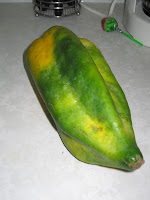Ecuador has several foods for which it is known. Guinea pig, or cuy, is one, but I haven't tried that one yet. It isn't as common here in the Oriente (eastern part of the country). Mariscos, or seafood, are common on the costa (coast). Some foods, such as bananas and sometimes strawberries and the Costa Rican fruit I knew as mamón chino, go by different names here (guineo - bananas, frutilla - strawberries, mamones - achotillo here, lychee to my Asian friends in med school, rambutan in Wikipedia).
I did get to out with some of the residents to nearby Puyo to try volquetero. From what I can tell, it is sort of like a poor man's ceviche, made from a mix of chocho (a bean-like fruit/seed), maiz tostado (toasted corn), chifles (dried banana chips), tuna, and a salad of cebolla (onion) and tomate (tomato). It was great! I also got to try encebollado at a special breakfast at work, a traditional breakfast food, which also includes chifles, fish, tostados, yucca, tomato, and ají.
Most of the other foods I have tried have been fruits. Many are made into jugos (juices) that I drink at each lunch I buy: frutilla/fresa (strawberry), mora (raspberry), tomate de arbol (tree tomato), guayaba (guava), guanabana, naranjilla (little orange), granadilla, etc. Some of the ones I got at the store as well as others are pictured below.



Not pictured are the papaya I recently bought at a small stand here in Shell and the lemons (called that although they're more like a cross between a lemon and a lime) we pick off a tree outside the residents' house to squeeze onto fish, avocado, and many other things. Most Ecuadorian main dishes are accompanied by ahí, the national version of hot sauce that I think also has garlic and onions in it. It's not very hot, at least in my limited experience, but does add a nice additional flavor. Patacones (fried green plantains) seem to be a common side in restaurants, but platanos maduros (fried ripe plantains) are less common although often available upon request. Yucca is common, both as a side and in soups. Soups are very common - every lunch I buy has a soup on the side. I have not found a lot of vegetables besides tomatoes, and I am very much looking forward to getting home, starting my garden, and eating my usual half-plateful of vegetables each night for dinner. That said, I will miss trying new things, drinking freshly made jugos, and how cheaply I can buy fresh fruit here.
Mamones, or achotillo, or lychee.
I did get to out with some of the residents to nearby Puyo to try volquetero. From what I can tell, it is sort of like a poor man's ceviche, made from a mix of chocho (a bean-like fruit/seed), maiz tostado (toasted corn), chifles (dried banana chips), tuna, and a salad of cebolla (onion) and tomate (tomato). It was great! I also got to try encebollado at a special breakfast at work, a traditional breakfast food, which also includes chifles, fish, tostados, yucca, tomato, and ají.
This is pretty much what our volquetero looked like, including the chunk of tuna from a can on top!
Most of the other foods I have tried have been fruits. Many are made into jugos (juices) that I drink at each lunch I buy: frutilla/fresa (strawberry), mora (raspberry), tomate de arbol (tree tomato), guayaba (guava), guanabana, naranjilla (little orange), granadilla, etc. Some of the ones I got at the store as well as others are pictured below.
Pepino dulce, or sweet cucumber. It was a fairly mild, bland, crisp fruit. The name is appropriate.
Babaco, which is currently sitting in my fridge as I wait for it to turn more yellow, is supposed to be good made into a juice. There is a blender in my apartment, so I plan on figuring out how to use it. (We don't have one at my home in Lancaster, and I've never done much with one. I think you just push buttons. How hard can it be?) :)
Maracuyá, or passionfruit, is the yellow fruit which has a tart inside usually made into juice. A patient gave me a whole bag of tomate de arbol, the red fruit above, so I need to make that into juice, too.

I don't remember what this one is called. I think I'm supposed to just cut it up and eat it.


This is granadilla, which has sweet pulp surrounding black seeds on the inside, all of which you eat (although not the shell.
Not pictured are the papaya I recently bought at a small stand here in Shell and the lemons (called that although they're more like a cross between a lemon and a lime) we pick off a tree outside the residents' house to squeeze onto fish, avocado, and many other things. Most Ecuadorian main dishes are accompanied by ahí, the national version of hot sauce that I think also has garlic and onions in it. It's not very hot, at least in my limited experience, but does add a nice additional flavor. Patacones (fried green plantains) seem to be a common side in restaurants, but platanos maduros (fried ripe plantains) are less common although often available upon request. Yucca is common, both as a side and in soups. Soups are very common - every lunch I buy has a soup on the side. I have not found a lot of vegetables besides tomatoes, and I am very much looking forward to getting home, starting my garden, and eating my usual half-plateful of vegetables each night for dinner. That said, I will miss trying new things, drinking freshly made jugos, and how cheaply I can buy fresh fruit here.






the granadilla looks like a pomegranate. yummy fruit! wish i could have some! i know, i'm looking forward to summer vegetables too in a month or so!
ReplyDelete-Bekah